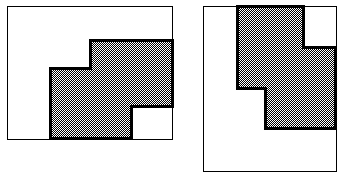 8.6. Disadvantages of Quadtrees
8.6. Disadvantages of Quadtrees  8.6. Disadvantages of Quadtrees
8.6. Disadvantages of Quadtrees The main disadvantage of quadtrees is that it is almost impossible to compare two images that differ only in rotation or translation. This is because the quadtree representation of such images will be so totally different.
The algorithms available for rotation of an image are restricted to rotations of 90 degrees (or multiples thereof). No other rotation is available, nor is there a facility for translation.
Although quadtrees have many advantages in GIS they tend to
be disadvantaged in other fields such as visualisation. The
problems start to occur when the image is rotated. This rotation
will completely change the quadtree of the image. Once the
quadtree has changed it becomes a difficult task to compare it to
an earlier version quadtree. Therefore quadtrees have poor shape
analysis and pattern recognition.

Fig. 8.6 : First image and rotated image, different quadtrees












